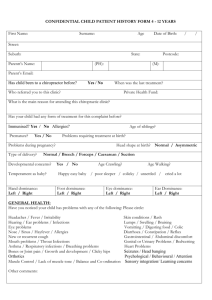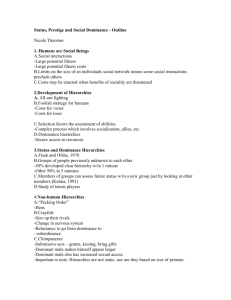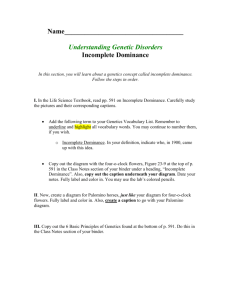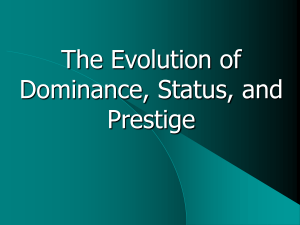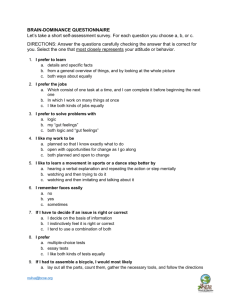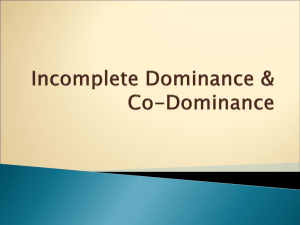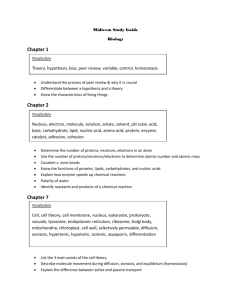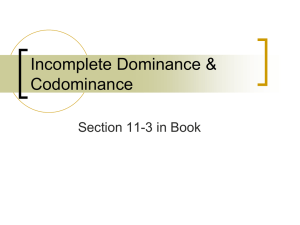Status, Prestige and Social Dominance
advertisement
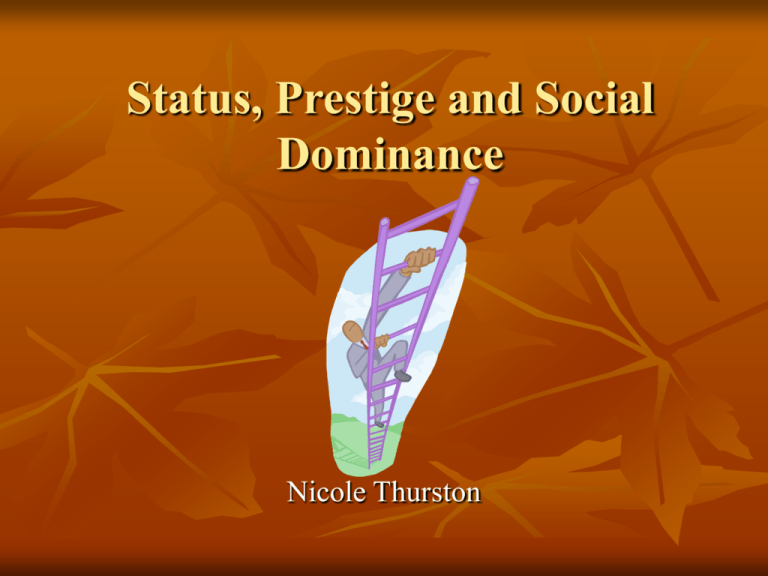
Status, Prestige and Social Dominance Nicole Thurston Objectives Learn about status, prestige, and social dominance Learn how these relate today and how they applied to our ancestors Learn about non-human behaviors Think critically about questions involving our social interactions and how/if our interactions apply to the evolutionary perspective To have fun! Humans are Social Beings Social interactions Large potential fitness Large potential fitness costs Limits on the size of an individuals social network means some social interactions preclude others Costs may be enacted when benefits of sociality are threatened Development of Hierarchies All-out fighting Do you think there are any positive outcomes to fighting? Selection favors the assessment of abilities Complex process which involves socialization, allies, etc. Dominance hierarchies Foolish strategy for humans Costs for victor Costs for loser Secure access to resources Production hierarchies People working together to achieve a group goal Status and Dominance Hierarchies Fisek and Ofshe, 1970 Groups of people previously unknown to each other 50% developed clear hierarchy w/in 1 minute Other 50% in 5 minutes Members of groups can assess future status w/in a new group just by looking at other members Study of tennis players (Kalma, 1991) Non-human Hierarchies “Pecking Order” Crayfish Hens Size up their rivals Change in nervous system Reluctance to go from dominance to subordinance Chimpanzees Submissive acts – grunts, kissing, bring gifts Dominant male makes himself appear larger Dominant male also has increased sexual access Important to note: Hierarchies are not static, nor are they based on size of primate. http://www.wildchimps.org/wcf/suedgruppe/videoclip.htm http://www.youtube.com/results?search_query=chimpanzee+socializing Status Hierarchies in Adolescence Priority of access to resources in competitive situations School shootings “The jocks rule the school…” “Are they going to accept me?” “It’s a rat race inside the school to see who’s going to be more popular.” Columbine Clip Why did they do it? http://www.youtube.com/watch?v=GFdqXxv4vsM Status Hierarchies in Adolescence Hormonal change Triggers aggression and risky behaviors in adolescent boys Physical maturity / Economic immaturity Teenage male frustrations are a new concept Aggressive energy is needed to meet challenges of entering adult life Do you think recent adolescent crimes are due to a lack of economic maturity and a desire to gain status in the world? Status Seeking Willingness to take risks Necessary in status competition “A race car driver at the 24-hour LeMans race, when asked why he always drove his car right at the edge of a curve, inches from death, replied that if you don’t drive that way, you lose the race.” (Bridgeman, p. 190) Do all high status individuals take some sort of risk to get where they are today…or are there other factors that may contribute to status? How did you develop your status? Born into classes? Do you actively seek your status? Caste System – Hindus A Place in the Sun Clip – The New Guy Is it that easy to gain status? http://www.youtube.com/watch?v=5KQQvz3MP64 Specific Physiological Mechanisms Neuroendocrine responses to challenge Autonomic Nervous System releases Cortisol & Adrenaline Competitive games (player or observer) SES and neuroendocrine activity Perceived social status compared to others Higher baseline cortisol levels, more sensitive stress response during conflict Therefore… Neuroendocrine responses are bidirectional Perceived social status influences hormone levels Hormone levels change an individual’s perceived social status and their interaction with the world AIDS Schizophrenia Status and Health (Buss, 2005) Infectious disease and disability Results in disgust and avoidance of unhealthy individuals Costs of failing to ID health threats Leads to human bias in the direction of overperception of threat Mechanism designed to protect people from contagion. From an EP this makes sense. However, what about individuals who choose to work with the disabled and chronically ill? (Rehabilitators, Doctors…) Sex Differences in Status Striving MUCH more prevalent among men than women Direct relationship between status and reproductive success Ceiling for male reproduction is much higher than for women Stronger selection pressure to succeed in reproduction Investment in pregnancy and lactation Female reproduction is limited by access to resources Male reproduction is limited by access to mates Sex Differences in Status Striving Buss suggests that high status women may also maintain higher reproductive advantages. Do you agree? Would lower status men find higher status women more intimidating? - A Polygamy reversal Status = Access to Mates Nobles, Princes, etc. Harems of Women Middle Class men 3-4 women In Western cultures where monogamy & higher status women are present, high-status men are still preferred as mates and partners in affairs. (Baker & Bellis, 1995; Perusse, 1993) Any thoughts as to why this might be? Preference for Dominant Males Research by Bereczkei et al., 1997 Women prefer altruistic males for longterm mates Women prefer brave, non-altruistic, risk-prone males for short-term mates Females found dominant males to be very sexually attractive, but men did not find dominance in females to be sexually attractive In a way this seems to perpetuate a gender role society. Dominance Motivation Social Dominance Orientation (SDO) (Pratto, Sidanius, & Stallworth, 1993) A scale which described preference for social hierarchies Those who score high on scale endorse group dominance over other groups SDO should be higher in men Access to Women Women select for men with high SDO Social Dominance Orientation From an evolutionary perspective, it makes sense that ancestral women would prefer a mate with a higher SDO. Why do these results reign true today, even in egalitarian cultures? How do you exert your authority? Gender Differences in Expression of Dominance Prosocial Dominant Acts versus Egoist Dominant Acts Women think Prosocial Dominant Acts are more socially desirable And actually performed more of these tasks Whereas… Men think Egoist Dominant Acts are more socially desirable And actually performed more of these tasks Continuation of this study by Megargee (1969) Paired high-dominant man/low-dominant man Paired high-dominant woman/low-dominant woman Paired high-dominant man/low-dominant woman Paired high-dominant man/low-dominant man Participants of groups were told they had to work together to repair a box given to them as quickly as possible Results – Who became the leader? 75% high-dom. men and 70% women emerged as leaders with their same sex 20% high-dom. men when paired with lowdom. women emerged as leaders Only 20% high-dom. women when paired with low-dom. men emerged as leaders WHY? Appointing of position – group oriented goals How do these gender differences in leadership and dominance play a role in today’s society? How about from an evolutionary perspective? Relational Aggression Women may express social dominance in a less overt, less physical, and more emotional way Men express social dominance in more physical and overt ways - Laguna Beach clip - http://www.youtube.com/watch?v=L8Ksl79V5po&search=Laguna%20Beach Dominance Theory Selection favors dominance, but also favors subordinate strategies to displace the dominant person Dominance Theory has two main propositions 1. There are social norms regarding permissions, obligations, and prohibitions 2. These emerge before reasoning strategies Deontic versus indicative reasoning Dominance Theory Allows children to organize transitive dominance hierarchies A > B > C …A is greater than C Social reasoning is strongly influenced by rank Evolved selective attention and memorial storage mechanisms “Cheater” Study What are the benefits of these mechanisms? Dominance Theory Other studies Anger or frustration increases blood pressure Aggression towards person who caused anger leads to decrease in BP if the person is low status If the person who caused your anger is higher in status, you BP will remain high Any thoughts as to why, physiologically, this happens? Social Attention-Holding Theory An emotional component of dominance Resource-holding potential Evaluation of yourself Results in attacking, submitting, or fleeing In this sense, dominance is a relationship not something possessed by one individual. Social attention-holding potential Competition for quality and quantity of attention from others Emotions Going up in rank Elation Increase in helping behavior Loss of status Shame – bodily movements coincide with feelings Rage – justifies retaliation Envy – emulate someone (positive manifestation) or belittle your idol (negative manifestation Depression – may result in submissiveness Indicators of Dominance Dominant individuals Stand at full height, don’t smile often, speak in a loud voice For men, a faster walking pace means higher status Evolutionary perspective Are usually tall or are perceived as being tall Higher salary Other correlates of dominance Athleticism Intelligence Physical attractiveness Humorousness Good grooming *A broad theory of the determinants of dominance is needed to better understand why some people are valued more than others. Self-Esteem Sociometer Theory Serves as a gauge for other’s evaluations From an evolutionary perspective, since humans evolved in groups, self-esteem provided a way to track the degree one was accepted by others Motivational mechanism Provides accurate self-assessments Submissiveness The idea of deceiving down Actual reduction in self-esteem to help facilitate acting in a subordinate manner Adaptive mechanism to avoid threats from the dominant Allows one to bide their time until a more opportune moment to seek a higher status arises The Downfall of “Tall Poppies” Experiencing pleasure in another’s misfortune Pleasure is felt when the status of a poppy is made salient, especially if the low-status individual has low self-esteem
